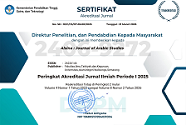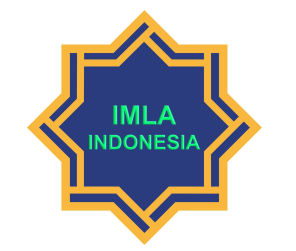Implementasi Pembelajaran Bahasa Arab Materi Qawāʿid Menggunakan Media Visual Wall Chart di Madrasah Aliyah
DOI:
https://doi.org/10.21580/alsina.6.2.22325Keywords:
Arabic language learning, grammar instruction, SECTIONS guidelines, wall chart mediaAbstract
This study evaluates Arabic grammar (qawāʿid) instruction using visual wall charts in class XD at MA NU 03 Sunan Katong, Kaliwungu, Kendal, during the 2023/2024 academic year, assessing alignment with the SECTIONS framework. Employing a qualitative descriptive approach, the study involved the Arabic teacher, principal, and 33 students, with data collected via observations, interviews, documentation, and assessment records, analyzed using triangulation. Findings reveal that instruction comprises preparation (material development, wall chart creation), implementation (introducing concepts, examples, question-and-answer sessions, interactive exercises, discussions), and follow-up (group assessments, daily quizzes). The wall chart improved student outcomes, with an average score of 81 (meeting ≥75 criteria), notably for 70% of students without Arabic knowledge, and enhanced engagement among 60.6% visual learners. Per the SECTIONS framework, the wall chart aligns with seven criteria (Students, Ease of Use, Cost, Teaching and Media Selection, Interaction, Organizational Issues, Security and Privacy). However, it lacks Networking alignment due to its non-digital nature. Wall charts are effective for qawāʿid in resource-limited settings, though digital integration could enhance learning resources. Future research should explore multimodal approaches to accommodate diverse learning styles.
Downloads
References
Alfurochmatin, Anisa, and A M Bin Mat Jusoh. “Tren pengembangan media pembelajaran bahasa Arab di Indonesia era 5.0.” Alsina: Journal of Arabic Studies 6, no. 1 (2024): 1–26. https://doi.org/10.21580/alsina.6.1.21278.
Azizah, Sarah Mar’atul. The Use of Wall Chart to Improve Students’ Vocabulary Mastery at Grade IV Students of SDN Gambiranom in the Academic Year 2015/2016 (Undergraduate Thesis). Yogyakarta: Universitas Negeri Yogyakarta, 2016.
Bates, A. W., and Gary Poole. Effective Teaching with Technology in Higher Education: Foundations for Success. San Francisco: Jossey-Bas, 2003.
Creswell, John W., and Cheryl N. Poth. Qualitative Inquiry & Research Design: Choosing Among Five Approaches. Thousand Oaks, CA: SAGE Publications, Inc., 2018.
Denzin, Norman K. The Research Act: A Theoretical Introduction to Sociological Methods. New York: Routledge, 2017. https://doi.org/10.4324/9781315134543.
Farid, Muhammad et al. “Analisis Kesulitan Belajar Bahasa Arab Siswa Kelas IX di SMP IT Insan Cendikia Makassar.” Education and Learning Journal 3, no. 1 (2022): 36–44. https://doi.org/10.33096/eljour.v3i1.148.
Halwani, Noha. “Visual Aids and Multimedia in Second Language Acquisition.” English Language Teaching 10, no. 6 (2017): 53–59. https://doi.org/10.5539/elt.v10n6p53.
Hamid, M Abdul et al. Pembelajaran Bahasa Arab: Pendekatan, Metode, Strategi, Materi, Dan Media. Malang: UIN-Malang Press, 2008.
Hamidi, Kurniawan et al. “Pengembangan Media Pembelajaran Bahasa Arab Berbasis Video Animasi Interaktif untuk Siswa Madrasah Aliyah.” Journal on Education 5, no. 2 (2023): 5289–96. https://doi.org/10.31004/joe.v5i2.1098.
Handani, Handani et al. “Penggunan Media Wall Chart dalam Peningkatan Penguasaan Mufradat di MIN 2 Takalar.” Al-Fashahah: Journal of Arabic Education, Linguistics, and Literature 2, no. 1 (2022): 18–30. https://doi.org/10.59562/al-fashahah.v2i1.34045.
Humaidah, Humaidah, and Luthfiyah Khoirun Nisa’. “Problematika Non-Linguistik Pembelajaran Bahasa Arab Kurikulum 2013 Pascapandemi Covid-19 Di MI Darul Ulum Ngaliyan Semarang.” Alsina : Journal of Arabic Studies 4, no. 2 (2022): 189–214. https://doi.org/10.21580/alsina.4.2.14599.
Istiqomah. Implementasi Media Audio-Visual dalam Pembelajaran Bahasa Arab Kelas VII MTs Negeri Kabupaten Purbalingga (Undergraduate Thesis). Purwokerto: IAIN Purwokerto, 2017.
Jalinus, Nizwardi, and Ambiyar. Media dan Sumber Pembelajaran. Jakarta: Kencana, 2016. https://books.google.co.id/books?id=wBVNDwAAQBAJ&hl=id&source=gbs_navlinks_s.
Letmiros, Letmiros. “Arabic: Why Indonesian Have to Learn It?” International Review of Humanities Studies 4, no. 2 (2019): 610–24. https://doi.org/10.7454/irhs.v4i2.166.
Mathew, Nalliveettil George, and Ali Odeh Hammoud Alidmat. “A Study on the Usefulness of Audio-Visual Aids in EFL Classroom: Implications for Effective Instruction.” International Journal of Higher Education 2, no. 2 (2013): 86–92. https://doi.org/10.5430/ijhe.v2n2p86.
Miles, Matthew B., and A. Michael Huberman. Qualitative Data Analysis: An Expanded Sourcebook. 2nd ed. Thousand Oaks: SAGE Publications, 1994.
Morett, Laura M. “The Power of an Image: Images, Not Glosses, Enhance Learning of Concrete L2 Words in Beginning Learners.” Journal of Psycholinguistic Research 48, no. 3 (2019): 643–64. https://doi.org/10.1007/s10936-018-9623-2.
Mu’mirotun, Laeli. Penggunaan Media Wall Chart dalam Meningkatkan Hafalan Mufradāt Bahasa Arab Kelas V MI Ma’arif Kanigoro Ngablak Magelang (Undergraduate Thesis). Yogyakarta: UIN Sunan Kalijaga Yogyakarta, 2019. https://digilib.uin-suka.ac.id/id/eprint/37212/.
Mufidah, Zahratul Maujudatul, and Kholifatul Khofifah. “The Implementation of Wall Chart Media to Improve Students’ Vocabulary Mastery in EFL Classroom.” Journal of Language Intelligence and Culture 6, no. 1 (2024): 1–12. https://doi.org/10.35719/jlic.v6i1.146.
Muh Arif, and Eby Waskito Makalalang. Pengembangan Media Pembelajaran Bahasa Arab. Edited by Muniroh. Prosiding Konferensi Nasional Bahasa Arab. Vol. 10. Padang: Lembaga Pendidikan dan Pelatihan Balai Insan Cendekia, 2020.
Perez, Maribel Montero. “Second or Foreign Language Learning through Watching Audio-Visual Input and the Role of on-Screen Text.” Language Teaching 55, no. 2 (2022): 163–92. https://doi.org/10.1017/S0261444821000501.
Prananingrum, Afiffah Vinda et al. “Kajian Teoritis Media Pembelajaran Bahasa Arab.” In Prosiding Konferensi Nasional Bahasa Arab VI, 303–19. Malang: Universitas Negeri Malang, 2020. https://prosiding.arab-um.com/index.php/konasbara/article/view/717.
Rosyidi, Abdul Wahab. Media Pembelajaran Bahasa Arab. Malang: UIN Malang Press, 2009.
Shidiq, Fauzie Muhammad et al. “Exploring The Position and Role of Arabic in Indonesian Society: A Descriptive Analysis.” Al-Ta’rib : Jurnal Ilmiah Program Studi Pendidikan Bahasa Arab IAIN Palangka Raya 11, no. 2 (2023): 275–92. https://doi.org/10.23971/altarib.v11i2.6899.
Suffah, Muh Ahlus. “Efektivitas Media Wall Chart dalam Meningkatkan Hasil Belajar Bahasa Arab Siswa Kelas X.” Al-Maraji’ : Jurnal Pendidikan Bahasa Arab 8, no. 1 (2024): 43–52. https://doi.org/10.26618/almaraji.v8i1.16189.
Downloads
Published
How to Cite
Issue
Section
License
Copyright (c) 2024 Alsina : Journal of Arabic Studies

This work is licensed under a Creative Commons Attribution-NonCommercial-ShareAlike 4.0 International License.
Copyright
The copyright of the received article shall be assigned to the publisher of the journal. The intended copyright includes the right to publish the article in various forms (including reprints). The journal maintains the publishing rights to published articles. Authors are allowed to use their articles for any legal purposes deemed necessary without written permission from the journal, but with an acknowledgment to this journal of initial publication.
Licensing
In order for Alsina: Journal of Arabic Studies to publish and distribute research articles, the editors need publishing rights (transferred from author to publisher). This agreement relates to the transfer/publishing copyright license to Alsina: Journal of Arabic Studies but the authors still have significant rights to use and share their published articles.
Alsina: Journal of Arabic Studies supports the need for writers to share, disseminate and maximize the impact of their research and their rights on any database. As a journal article writer, you have the right to various uses of your articles, including that by the institution or company where you work. Copyright can be used without the need for special permission. Authors who publish articles in the Alsina: Journal of Arabic Studies have broad rights to use their work for teaching and scientific purposes without requesting permission, including:
- Use by the author for lectures, presentations, or conferences, with distribution of copies to participants;
- Distribution to colleagues for research use;
- Use in compilations of the author's subsequent work;
- inclusion in a thesis or dissertation;
- Reuse of sections or excerpts from articles in other works (with full acknowledgment of the final article);
- Preparation of derivative works (other than commercial purposes) (with full acknowledgment of the final article);
- Voluntary posting on open websites operated by authors’ or writers' agencies for scientific purposes
When submitting a manuscript, authors do so on the understanding that if accepted for publication, the copyright for publishing (publishing right) of the article shall be assigned/transferred to Alsina: Journal of Arabic Studies.
Authors whose articles are accepted for publication will receive confirmation via email and sent a Copyright Transfer Agreement.

 Accreditation
Accreditation 
 In Collaboration with
In Collaboration with 

 Visitors
Visitors  Article Template
Article Template





